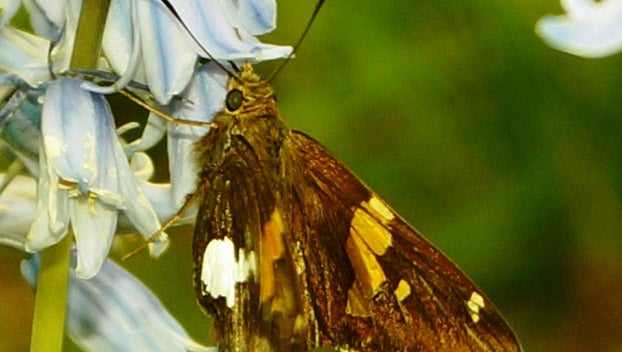Skippers and butterflies and moths! Oh my!
Published 10:00 am Saturday, September 3, 2022

- Photo by John Bunch Pictured here is a Silver-Spotted Skipper. Skipper is one of the two groups into which all butterflies are divided.
|
Getting your Trinity Audio player ready...
|
By John Bunch
Virginia Master Naturalists
When we see butterflies and moths, we generally recognize which of the two we are looking at. They are separated from each other by their differing body structures, their habits, and the way the veins are set up in their wings. Butterflies fly during the day and most moths fly at night, although there are some that fly during the daytime, such as the Clearwings. While at rest, butterflies tend to hold their wings vertically over their back, while in contrast, moths may either fold the wings tent-like over the back, extend them out to the sides, or wrap them around their body. The antennae differ between the two groups as well. Moth antennae are thread-like in the females and feathery in the males, whereas the butterflies are like slender rods with clubs on the ends.
So where do Skippers fit in on all this? Butterflies are divided into two groups: the True Butterflies and the Skippers. Skippers are, after all, butterflies, and they get their name for their quick, darting flight habits with generally short flight periods. There are some anatomical differences between the two. The True Butterflies tend to have narrow bodies and brightly colored full wings, whereas the Skippers have short triangular well-rounded wings, most often being a shade of tawny orange, brown, black or gray and with chunkier bodies. The True Butterflies have what’s considered to be clubbed antennae, that is, the tips are shaped into a club-like form, while the Skippers have their antennae tips hooked backwards like a crochet hook.
But the Skippers also share similarities with moths. They resemble moths by having stocky, compact, and often hairy bodies and their heads are broad as well.
There are two types of Skippers, the Spread-wing and the Folded-wing. When resting, the Folded-wings hold their short wings much like a butterfly in a near vertical position over its body, but those wings are held at different angles to each other. The Spread-wings hold theirs open as a moth.
So this puts the Skippers into an intermediate stage between the moths and butterflies.
So when you see a butterfly and you’re not sure about it, ask yourself these questions: Do the antennae have clubs or hooks? What is its flight pattern like? Does the body seem to be large and hairy? Answer these, and you’ll know for sure whether it’s a Skipper or a True Butterfly


